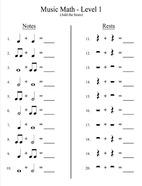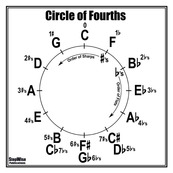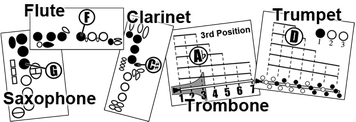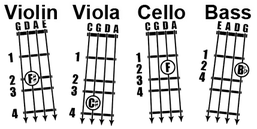Home of NinGenius Music & StepWise Publications
|
|
|
|
NinGenius Music: The App
The NinGenius Music App is the best app for learning and assessing Note Names, Fingerings, Rhythm and other critical Music Theory. It is now available on iOS, Android and Kindle Fire! Learn more by clicking HERE.
|
Free Fingering ChartsUse these charts with all your music students to help them make sense of the fingering patterns on their instruments. Every note in the essential range is shown on one page!
|
Free Music Worksheets
Each worksheet can be used to quiz or test your students' musical knowledge. Topics include rhythm, note durations, note naming, accidentals, key signatures, and fingerings.
|
Free Music Posters
Download free giant high-resolution posters for your band or orchestra room, including the Circle of Fourths and the Sound Pyramid concept devised by Francis McBeth.
|
Nothing will help your students truly conquer their notes and fingerings like putting a set of flashcards in each of their hands and using them regularly. Just think of the possibilities: students working cooperatively together (incorporating the Zone of Proximal Development), competing against each other, and focusing on memorizing each note with an intensity that is not normally seen in the beginning band or orchestra room! Impromptu quizzes with no teacher preparation needed! Parents (who know nothing about music) quizzing and teaching their own student musicians how to play each note on the staff! All of this is possible because we have made an extremely affordable set of printable flashcards that you can use year after year. Click here to visit our Store now.
StepWise Flashcards |
Curtis Winters, Music Educator and Author
|
Why StepWise Charts and Flashcards?
This website is dedicated to helping every music student succeed! After many years of teaching beginning band and beginning orchestra I had become increasingly frustrated with my inability to help each and every young musician grasp the basic concepts of note reading and fingering their instruments. I figured I could find a good set of flashcards for each instrument's notes and fingerings it would be a tremendous help for many of them, and provide a powerful learning activity in my classes. So I searched online.
I found a grand total of...ONE such set of flashcards. So I bought them - a reproducible set of flashcards for every band instrument from Berets Publications - click HERE to see them. Now it appears that they no longer sell a reproducible set, and only provide individual instrument cards through other dealers (no online store). These are good flashcards, but I was disappointed with FOUR things: 1) The graphics were angular and pixelated, 2) The set included only 18 notes for each instrument - which meant that each instrument was missing 8-12 notes, 3) When I printed them double-sided the cutting lines would be slightly uneven, causing the cards to be slightly different sizes, and 4) The note names and certain instrument parts are tiny and hard to see, while other elements are proportionally too big. Call me OCD, but those four issues were enough to discourage me from using them enthusiastically. Instead, I got to work on Photoshop and began to make my own!
Like Steve Jobs of Apple Computers I care deeply about beauty and function. I carefully crafted each instrument's graphic representation to be attractive, functional, and as intuitive as possible. I chose to show only the most common enharmonic so that beginners would not be confused or so the graphics would not be too cluttered. I decided to create different groups of flashcards so that students could pull out certain cards from the whole deck into useful sub-sets, such as 1) The first 5 notes, 2) The first 12 notes, 3) A one-octave chromatic scale, and 4) Other major scales. These sub-sets can be created by using the little icons on the fronts of the cards...Smiley Face, Triangle, Star, etc. I also gave each card a number which organizes them by Concert Pitch across the entire band or orchestra and created an amazing Teacher's Guide which allows the director to get all students working on whichever notes they need to study and memorize over the entire range of each instrument. These flashcards have been such a delight to use with my students, because they are both beautiful and versatile!
After creating all the flashcards and making them available as reproducible/printable sets for music teachers I set my heart on creating the perfect fingering chart for each instrument. I think you will find no better charts for beginning musicians ANYWHERE on the internet. Plus, each is available for free as a high-quality, high-resolution PDF download from this website - click here to get every chart now!
I found a grand total of...ONE such set of flashcards. So I bought them - a reproducible set of flashcards for every band instrument from Berets Publications - click HERE to see them. Now it appears that they no longer sell a reproducible set, and only provide individual instrument cards through other dealers (no online store). These are good flashcards, but I was disappointed with FOUR things: 1) The graphics were angular and pixelated, 2) The set included only 18 notes for each instrument - which meant that each instrument was missing 8-12 notes, 3) When I printed them double-sided the cutting lines would be slightly uneven, causing the cards to be slightly different sizes, and 4) The note names and certain instrument parts are tiny and hard to see, while other elements are proportionally too big. Call me OCD, but those four issues were enough to discourage me from using them enthusiastically. Instead, I got to work on Photoshop and began to make my own!
Like Steve Jobs of Apple Computers I care deeply about beauty and function. I carefully crafted each instrument's graphic representation to be attractive, functional, and as intuitive as possible. I chose to show only the most common enharmonic so that beginners would not be confused or so the graphics would not be too cluttered. I decided to create different groups of flashcards so that students could pull out certain cards from the whole deck into useful sub-sets, such as 1) The first 5 notes, 2) The first 12 notes, 3) A one-octave chromatic scale, and 4) Other major scales. These sub-sets can be created by using the little icons on the fronts of the cards...Smiley Face, Triangle, Star, etc. I also gave each card a number which organizes them by Concert Pitch across the entire band or orchestra and created an amazing Teacher's Guide which allows the director to get all students working on whichever notes they need to study and memorize over the entire range of each instrument. These flashcards have been such a delight to use with my students, because they are both beautiful and versatile!
After creating all the flashcards and making them available as reproducible/printable sets for music teachers I set my heart on creating the perfect fingering chart for each instrument. I think you will find no better charts for beginning musicians ANYWHERE on the internet. Plus, each is available for free as a high-quality, high-resolution PDF download from this website - click here to get every chart now!









